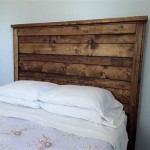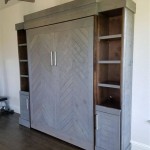How To Build A Murphy Bed Without a Kit
A Murphy bed, also known as a wall bed, offers a space-saving solution for small apartments, guest rooms, or home offices. While pre-made kits are readily available, building a Murphy bed from scratch provides a more customized experience and often allows for cost savings. This article will guide you through the process of constructing a Murphy bed without relying on a kit.
1. Planning and Design
Before starting construction, meticulous planning is essential. Determine the bed's dimensions, considering the available space and desired mattress size.
Determine the overall dimensions of the bed, taking into account the mattress size, frame thickness, and any additional features (like built-in shelving or storage). Consider the height of the bed when folded up against the wall, ensuring it does not obstruct any doorways or windows.
Choose the materials for the frame and the bed panels. Pine or plywood are popular options due to their affordability and workability. Plywood offers greater stability and resistance to warping. Consider using pre-finished boards or staining and sealing the wood after construction for a polished look.
Decide on the mechanism for folding and unfolding the bed. A simple hinge system requires less complex hardware but may not be as sturdy as a more robust mechanism. A gas spring-assisted system for unfolding is more convenient but involves additional costs and installation.
Draw detailed plans, including measurements for each component. This will serve as a blueprint for cutting the materials and assembling the frame.
2. Cutting and Assembling the Frame
Using precision tools, such as a circular saw, jigsaw, or table saw, cut the wood according to your plans. Ensure accuracy in cutting to guarantee a smooth assembly process.
Assemble the frame using wood glue and screws for secure joints. Start with the base, which will support the mattress. For the headboard and footboard, consider using thicker wood for added strength.
Attach the hinges to the frame. If using a gas spring system, follow the manufacturer's instructions for installation.
Create a support system for the bed when it is in the folded position. This can involve a sturdy wall-mounted frame or a combination of brackets and supports. Ensure this support is strong enough to handle the weight of the bed without sagging or collapsing.
3. Adding Finishing Touches
Once the frame is complete, you can add finishing touches to enhance its appearance and functionality.
Sand the entire frame to create a smooth surface. This will also ensure a clean and even application of paint or stain.
Apply paint or stain to the wood, taking care to cover all surfaces evenly. Consider using a protective sealant to enhance durability and waterproof the finish.
If desired, add decorative accents, such as moldings, trim, or hardware to enhance the aesthetics of the bed.
Create a storage compartment in the bed frame to utilize the space efficiently. This can be a simple shelving unit or a more elaborate drawer system.
Finally, install the mattress and ensure it fits securely within the frame.
Building a Murphy bed from scratch requires planning, precision, and a commitment to quality. With careful execution, you can create a functional and stylish piece of furniture that will save space and add a unique touch to your home.

Diy Murphy Bed For Under 150 With Plans Your Modern Family

Diy Horizontal Murphy Bed Without Kit And Design Inspiration Home Interiors

Diy Murphy Bed Using Old Doors Rustic Crafts

Diy Murphy Bed Without Expensive Hardware

Diy Murphy Bed Tutorial And

How To Build A Gorgeous Diy Murphy Bed Using Hardware Kit Plans

Murphy Bed Diy

Diy Murphy Bed Project From A Kit Girl Just

Diy Murphy Bed Ideas 5 Plans To Start Building This Weekend

Diy Modern Murphy Bed Huntress







